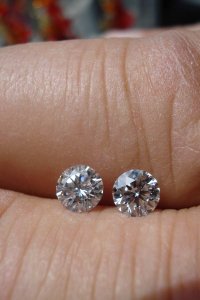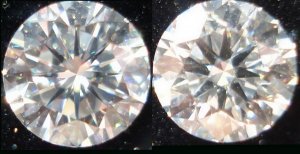- Joined
- Jan 7, 2009
- Messages
- 10,403
HI Everyone,
If there was no value in the questions I ask, there'd be no conversation.
If innocent consumers weren't getting extremely one sided answers daily, I would have less motivation to point out that opinions are quite often stated here as facts.
Is a well cut 60/60 better than a smaller table EX cut grade? No.
But the opposite is also true.
Criticizing advice where people are told to stay below 59% on table size is only me going for the "low hanging fruit"...that is to say, obvious misinformation being given.
There is absolutely no "scientific proof" a 60% table is in any way deficient to a 57% table.
The term "leakage" is so often used in a disparaging manner by consumers advising other consumers based on not enough information to make a meaningful observation. Every diamond leaks light- or it would simply be a mirror.
The term "performance" in relation to a diamond has no scientific basis whatsoever.
Neither of these terms works better on a round brilliant than they do for an octagonal vivid yellow. They are simply ways of trying to make something a black and white issue, as opposed to one of subjective values.
Todd mentioned that he has to buy without looking at diamonds therfore he relies on a "buy by the numbers" system. That may work extremely well for a professional who knows what he likes. But not necessarily so well for someone who has not had the benefit of seeing many different makes.
It also proves the point of this thread yet again.
What it sounds like is that people are reduced to stocking diamonds that fit some artificial mold, as opposed to diamonds that look good based on their actual appearance. The market responds by cutting diamonds to numbers that are repeated over and over again... the result is a lack of diversity, and it stifles creativity.
I could not agree more that there's a large component of the new informational technology encourages creativity- such as my ideas in this thread.
I started this thread as it's clear to me that along with the positive, the negative aspects of this are taking place in many areas of our lives- such as literature.
Oh- and unlike a few of the vocal critics posting here, I have absolutely nothing to be ashamed of in my posts.
If there was no value in the questions I ask, there'd be no conversation.
If innocent consumers weren't getting extremely one sided answers daily, I would have less motivation to point out that opinions are quite often stated here as facts.
Is a well cut 60/60 better than a smaller table EX cut grade? No.
But the opposite is also true.
Criticizing advice where people are told to stay below 59% on table size is only me going for the "low hanging fruit"...that is to say, obvious misinformation being given.
There is absolutely no "scientific proof" a 60% table is in any way deficient to a 57% table.
The term "leakage" is so often used in a disparaging manner by consumers advising other consumers based on not enough information to make a meaningful observation. Every diamond leaks light- or it would simply be a mirror.
The term "performance" in relation to a diamond has no scientific basis whatsoever.
Neither of these terms works better on a round brilliant than they do for an octagonal vivid yellow. They are simply ways of trying to make something a black and white issue, as opposed to one of subjective values.
Todd mentioned that he has to buy without looking at diamonds therfore he relies on a "buy by the numbers" system. That may work extremely well for a professional who knows what he likes. But not necessarily so well for someone who has not had the benefit of seeing many different makes.
It also proves the point of this thread yet again.
What it sounds like is that people are reduced to stocking diamonds that fit some artificial mold, as opposed to diamonds that look good based on their actual appearance. The market responds by cutting diamonds to numbers that are repeated over and over again... the result is a lack of diversity, and it stifles creativity.
I could not agree more that there's a large component of the new informational technology encourages creativity- such as my ideas in this thread.
I started this thread as it's clear to me that along with the positive, the negative aspects of this are taking place in many areas of our lives- such as literature.
Oh- and unlike a few of the vocal critics posting here, I have absolutely nothing to be ashamed of in my posts.













300x240.png)